
Ida, minor planet designation 243 Ida, is an asteroid in the Koronis family of the asteroid belt. It was discovered on 29 September 1884 by Austrian astronomer Johann Palisa at Vienna Observatory and named after a nymph from Greek mythology. Later telescopic observations categorized Ida as an S-type asteroid, the most numerous type in the inner asteroid belt. On 28 August 1993, Ida was visited by the uncrewed Galileo spacecraft while en route to Jupiter. It was the second asteroid visited by a spacecraft and the first found to have a natural satellite.
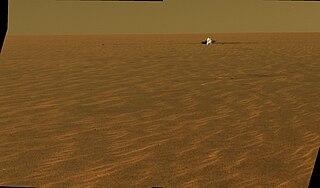
The Meridiani Planum (alternately Meridiani plain, Meridiani plains, Terra Meridiani, or Terra Meridiani plains) is either a large plain straddling the equator of Mars and covered with a vast number of spherules containing a lot of iron oxide or a region centered on this plain that includes some adjoining land. The plain sits on top of an enormous body of sediments that contains a lot of bound water. The iron oxide in the spherules is crystalline (grey) hematite (Fe203).
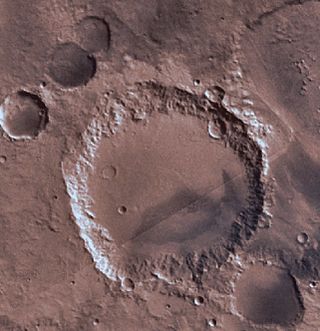
Beer is a crater lying situated within the Margaritifer Sinus quadrangle (MC-19) region of the planet Mars, named in honor of the German astronomer, Wilhelm Beer. It is located at 14.4°S 351.8°E.
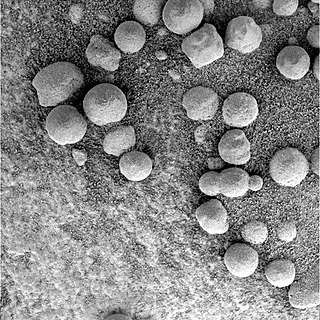
Martian spherules (also known as hematite spherules, blueberries, & Martian blueberries) are small spherules (roughly spherical pebbles) that are rich in an iron oxide (grey hematite, α-Fe2O3) and are found at Meridiani Planum (a large plain on Mars) in exceedingly large numbers.

An impact structure is a generally circular or craterlike geologic structure of deformed bedrock or sediment produced by impact on a planetary surface, whatever the stage of erosion of the structure. In contrast, an impact crater is the surface expression of an impact structure. In many cases, on Earth, the impact crater has been destroyed by erosion, leaving only the deformed rock or sediment of the impact structure behind. This is the fate of almost all old impact craters on Earth, unlike the ancient pristine craters preserved on the Moon and other geologically inactive rocky bodies with old surfaces in the Solar System. Impact structure is synonymous with the less commonly used term astrobleme meaning "star wound".

Koga is an impact crater on Mars, approximately 19 kilometers in diameter. It is located at 29.3°S, 103.8°W, north of the crater Virrat and northeast of the crater Dinorwic. To the north is the crater Nhill. It is named after a town in Tanzania, and its name was approved by the International Astronomical Union in 1991. According to a surface age map of Mars based on US Geological Survey data, the area around Koga is from the Noachian epoch, which places the area's age at 3.8 to 3.5 billion years ago. Sharp blocks and cliffs poke through a mantle of fine material located at the bottom of the crater. At the deepest part of the crater, it is about 5,200 meters in elevation above zero altitude, and its rim averages about 6,400 meters above zero altitude. It is therefore approximately 1.2 kilometers deep.

Kuiper is a moderate-size crater with a central peak cluster located at 11.35°S 31.23°W on Mercury. It is 62 kilometers in diameter and was named after Dutch-American astronomer Gerard Kuiper in 1976. It is one of only 2 Mercurian craters which are named not after artists, and one of very few cases when the same name is used for 3 craters. Gerard Kuiper, being a leader of American planetary science, died shortly before the first images of Mercurian surface were made.

Matisse is an impact crater on the southern hemisphere of Mercury. Matisse takes its name from the French artist Henri Matisse, and it was named by the IAU in 1976.
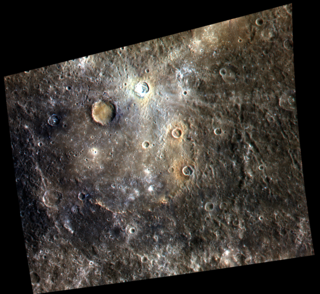
Homer is a crater on Mercury. It is one of 110 peak ring basins on Mercury.

Heimdal is a relatively recent impact crater on the planet Mars. It is a simple crater which lies in Vastitas Borealis, the northern plain. It is named after the Norwegian town of Heimdal.

Dilly is a crater in the Elysium quadrangle of Mars, located at 13.24° North and 202.9° West. It is only 1.3 km in diameter and was named after Dilly, a town in Mali.
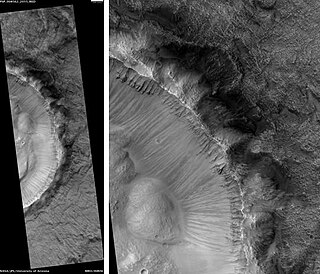
Grindavik is an impact crater in the Oxia Palus quadrangle of Mars, located at 25.39° North and 39.07° West. It is 12 km (7.5 mi) in diameter and was named after Grindavík, a town in Iceland. Impact craters generally have a rim with ejecta around them, in contrast volcanic craters usually do not have a rim or ejecta deposits. As craters get larger they usually have a central peak. The peak is caused by a rebound of the crater floor following the impact.
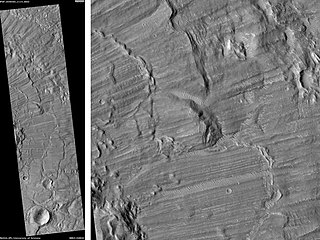
Bacolor is a crater in the Casius quadrangle of Mars, located at 33 North and 241.4 West. 20.8 kilometers (12.9 mi) in diameter, it is named after the municipality of Bacolor in Pampanga, Philippines.
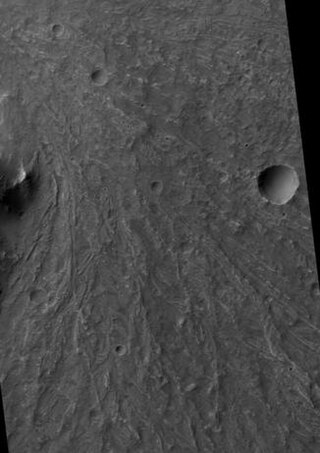
Saheki is a crater on Mars, located in the Iapygia quadrangle at 21.75° S and 286.97° W. It measures approximately 82 kilometers in diameter and was named after Tsuneo Saheki, a Japanese amateur astronomer (1916–1996). The naming was adopted by IAU's Working Group for Planetary System Nomenclature in 2006.

Futabatei is a crater on Mercury. It has a diameter of 57 kilometers. Its name was adopted by the International Astronomical Union in 1976. Futabatei is named for the Japanese novelist Futabatei Shimei, who lived from 1864 to 1909.

Gledhill is an impact crater in the Hellas quadrangle of Mars, located at 53.2°S latitude and 87.1°E longitude. It is 78.5 km in diameter. It was named after British astronomer Joseph Gledhill, and the name was approved in 1973 by the International Astronomical Union (IAU) Working Group for Planetary System Nomenclature (WGPSN).

















